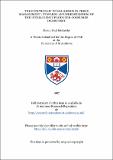Files in this item
The function of intelligence in crisis management : towards an understanding of the intelligence producer-consumer dichotomy
Item metadata
| dc.contributor.advisor | Hoffman, Bruce | |
| dc.contributor.author | McCarthy, Shaun Paul | |
| dc.coverage.spatial | 352 p. | en_US |
| dc.date.accessioned | 2018-07-13T10:48:19Z | |
| dc.date.available | 2018-07-13T10:48:19Z | |
| dc.date.issued | 1997 | |
| dc.identifier.uri | https://hdl.handle.net/10023/15356 | |
| dc.description.abstract | This study is an analysis of the relationship between intelligence and policy, focusing specifically on the role of intelligence in crisis management. The conventional wisdom on intelligence and crisis management tends to examine each subject in isolation of the other. This study therefore provides an integrated approach to the theory of the intelligence process and the principles of crisis management, identifying those factors that influence the producer - consumer relationship. Past analyses of the intelligence producer - consumer relationship have revolved around the normative theory of the traditionalist and activist disciplines, as set forth in the Kent-Kendall debate. This study transcends that boundary. Building on the traditional concept of the intelligence cycle by examining the application of intelligence in crisis management, the study demonstrates how in practice the cycle is disregarded and circumvented. It provides new insight into the complexities of the traditionalist and activist approaches to intelligence, while demonstrating how intelligence can be used in support of crisis management and decision making. Using terrorism as a crisis phenomenon, the study utilises as case studies the series of terrorist attacks against United States' interests and foreign policy objectives in Lebanon during the first Reagan Administration from 1983 to 1985. It analyses the reasons behind the intelligence failures in preventing the bombing of the two U.S. Embassies and the U.S. Marine Barracks in Beirut. It also reveals the consequences of the kidnapping of the CIA Chief of Station, William Buckley, and the implications of that event for American intelligence capabilities during the Lebanon crisis. The role of intelligence and the tension between the intelligence and the decision making communities, as well as the media, during the hijacking of TWA Flight 847, are also analysed. By examining each case study through a framework that combines the intelligence cycle and crisis management principles, the responses of the Reagan Administration to the above threats and incidents are analysed. The conflicts between key decision making individuals in the Reagan Administration and their influence on the intelligence analysis process is also examined. The study reveals the interactive role and influence of the National Security Council Staff as the producer - consumer interface and the influence of the media and public interest on crisis decision making. It concludes with a presentation of an intelligence and crisis management paradigm, with suggestions for further academic endeavour in this field. | en_US |
| dc.language.iso | en | en_US |
| dc.publisher | University of St Andrews | |
| dc.subject.lcc | JX1581.L3M3 | |
| dc.title | The function of intelligence in crisis management : towards an understanding of the intelligence producer-consumer dichotomy | en_US |
| dc.type | Thesis | en_US |
| dc.contributor.sponsor | University of St Andrews | en_US |
| dc.type.qualificationlevel | Doctoral | en_US |
| dc.type.qualificationname | PhD Doctor of Philosophy | en_US |
| dc.publisher.institution | The University of St Andrews | en_US |
This item appears in the following Collection(s)
Items in the St Andrews Research Repository are protected by copyright, with all rights reserved, unless otherwise indicated.

